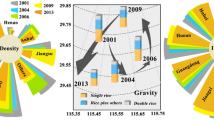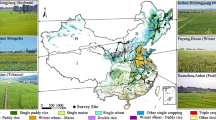Abstract
With a continuously increasing population and better food consumption levels, improving the efficiency of arable land use and increasing its productivity have become fundamental strategies to meet the growing food security needs in China. A spatial distribution map of medium- and low-yield cropland is necessary to implement plans for cropland improvement. In this study, we developed a new method to identify high-, medium-, and low-yield cropland from Moderate Resolution Imaging Spectroradiometer (MODIS) data at a spatial resolution of 500 m. The method could be used to reflect the regional heterogeneity of cropland productivity because the classification standard was based on the regionalization of cropping systems in China. The results showed that the proportion of high-, medium-, and low-yield cropland in China was 21%, 39%, and 40%, respectively. About 75% of the low-yield cropland was located in hilly and mountainous areas, and about 53% of the high-yield cropland was located in plain areas. The five provinces with the largest area of high-yield cropland were all located in the Huang-Huai-Hai region, and the area amounted to 42% of the national high-yield cropland area. Meanwhile, the proportion of high-yield cropland was lower than 15% in Heilongjiang, Sichuan, and Inner Mongolia, which had the largest area allocated to cropland in China. If all the medium-yield cropland could be improved to the productive level of high-yield cropland and the low-yield cropland could be improved to the level of medium-yield cropland, the total productivity of the land would increase 19% and 24%, respectively.
Similar content being viewed by others
References
Agricultural Natural Resources and Agricultural Regional Planning Institute of Chinese Academy of Agricultural Sciences, National Soil and Fertilizer Station, 1992. Chinese Arable Land Resources and Its Exploitation. Beijing: Surveying and Mapping Press. (in Chinese)
Albrizio R, Steduto P, 2003. Photosynthesis, respiration and conservative carbon use efficiency of four field grown crops. Agricultural and Forest Meteorology, 116(1): 19–36.
Ball J T, 1996. Sensitivity of leaf photosynthesis to CO2 concentration is an invariant function for C3 plants: A test with experimental data and global applications. Global Biogeochemical Cycles, 10(2): 209–222.
Cheng W X, Sims D A, Luo Y et al., 2000. Photosynthesis, respiration, and net primary production of sunflower stands in ambient and elevated atmospheric CO2 concentrations. Global Change Biology, 6(8): 931–941.
Foley J A, DeFries R, Asner G P et al., 2005. Global consequences of land use. Science, 309(5734): 570–574.
Foley J A, Ramankutty N, Brauman K A et al., 2011. Solutions for a cultivated planet. Nature, 478(7369): 337–342.
Gifford R M, 1995. Whole plant respiration and photosynthesis of wheat under increased CO2 concentration and temperature: Long-term vs. short-term distinctions for modelling. Global Change Biology, 1(6): 385–396.
Huang M, Ji J J, Peng L L, 2008. The response of vegetation net primary productivity to climate change during 1981–2000 in the Tibetan Plateau. Climatic and Environmental Research, 13(5): 608–617. (in Chinese)
Kalfas J L, Xiao X, Vanegas D X et al., 2011. Modeling gross primary production of irrigated and rain-fed maize using MODIS imagery and CO2 flux tower data. Agricultural and Forest Meteorology, 151(12): 1514–1528.
Li F L, Li B X, Cao W X, 2005. Status and prospect of crop-yield assess by remote sensing. Journal of Yunnan Agricultural University, 5(20): 680–684. (in Chinese)
Lin P S, 2008. Study on the distribution and possible production increase of medium and low-yield farmland in China. Beijing: Chinese Academy of Agricultural Sciences. (in Chinese)
Liu X H, Yang Q k, Tang G A, 2001. Extraction and application of relief of China based on DEM and GIS method. Bulletin of Soil and Water Conservation, 21(1): 57–62.
Shi Q H, Wang H, Chen F et al., 2010. The spatial-temporal distribution characteristics and yield potential of medium-low yielded farmland in China. Chinese Agricultural Science Bulletin, 26(19): 369–373. (in Chinese)
Tilman D, Balzer C, Hill J et al., 2011. Global food demand and the sustainable intensification of agriculture. Proceedings of the National Academy of Sciences, 108(50): 20260–20264.
Wang Y, Huang M, Wang X G, 2010. Impacts of land use and climate change on agricultural productivity in Shanghai. Acta Scientiae Circumstantiae, 30(3): 641–648. (in Chinese)
Wang Z, Xiao X M, Yan X D, 2010. Modeling gross primary production of maize cropland and degraded grassland in northeastern China. Agricultural and Forest Meteorology, 150(9): 1160–1167.
Wu B F, Du X, Meng J H et al., 2009. A remote sensing method to classify high, medium and low yield cropland and its application in Huang-Huai-Hai Basin. Modern Agricultural Development and National Food Security & Huang-Huai-Hai Modern Agricultural Development Strategy Forum Proceedings, 104–108. (in Chinese)
Xiao X M, Hollinger D, Aber J et al., 2004. Satellite-based modeling of gross primary production in an evergreen needleleaf forest. Remote Sensing of Environment, 89(4): 519–534.
Yan H M, Fu Y L, Xiao X M et al., 2009. Modeling gross primary productivity for winter wheat-maize double cropping system using MODIS time series and CO2 eddy flux tower data. Agriculture, Ecosystems & Environment, 129(4): 391–400.
Yan H M, Liu J Y, Huang H Q et al., 2012. Impacts of cropland transformation on agricultural production under urbanization and Grain for Green Project in China. Acta Geographica Sinica, 2012, 67(5): 579–588. (in Chinese)
Zhang L, Zhang F G, Jiang G H et al., 2005. Potential improvement of medium low yielded farmland and guarantee of food safety in China. Research of Agricultural Modernization, 26(1): 22–25. (in Chinese)
Zhang W, Li A N, 2012. Study on the optimal scale for calculating the relief amplitude in China based on DEM. Geography and Geo-Information Science, 28(4): 8–12. (in Chinese)
Author information
Authors and Affiliations
Corresponding author
Additional information
Foundation: STS Project of CAS, No.KFJ-EW-STS-001; National Natural Science Foundation of China, No.41430861
Yan Huimin, PhD, specialized in land use change
Rights and permissions
About this article
Cite this article
Yan, H., Ji, Y., Liu, J. et al. Potential promoted productivity and spatial patterns of medium- and low-yield cropland land in China. J. Geogr. Sci. 26, 259–271 (2016). https://doi.org/10.1007/s11442-016-1267-2
Received:
Accepted:
Published:
Issue Date:
DOI: https://doi.org/10.1007/s11442-016-1267-2




